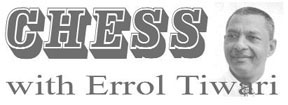We are approaching the final quarter of year 2014, and traditionally, there are three chess tournaments to be completed before the end of December. We have the National Junior Championship, the National Senior Championship and the National Schools Championship. Each of the three championships is significant for the continuation and propagation of the royal game.

He went on to say that chess was basically an obscure game, and to garner attention and sponsorship, an event of considerable proportions should occur in one’s country. In Guyana’s case, being a country that is practically non-existent on the international chess map, that event may well have been our participation at the 2014 Tromso Olympiad which made a few noticeable headlines following a 34-year-old hiatus. We know for certain that we have one thing in common with other prominent chess nations. We have our youngsters playing chess. And this circumstance represents our hope for the future. The team which represented Guyana at Tromso was comprised principally of our young grandmaster aspirants. It is therefore likely that for this year’s national junior championship tournament,

